
Italian postcard by Bromofoto, Milano, no. 346. Photo: Universal International.
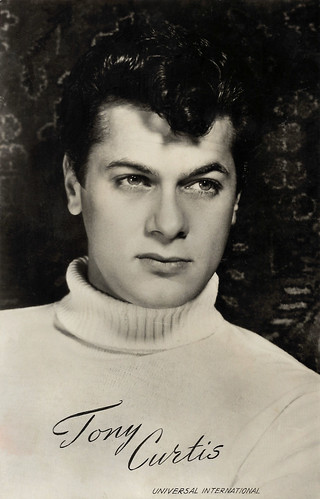
Dutch postcard by Uitg. Takken, Utrecht, no. 1314. Photo: Universal International.
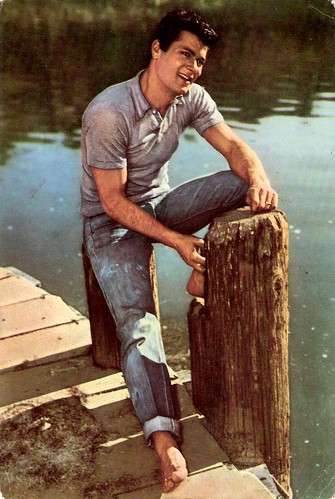
Dutch postcard by Gebr. Spanjersberg N.V., Rotterdam, no. 1008, mailed in 1960. Photo: Universum-Film Aktiengesellschaft, Berlin-Tempelhof (UFA).

Dutch postcard by Gebr. Spanjersberg, Rotterdam. Photo: UFA.

West-German postcard by Ufa/Film-Foto, Berlin-Tempelhof. Photo: Universal International. This postcard was made for the magazine Film Freund, no. 11-1956.

West-German postcard by Kunst und Bild, Berlin, no A 1111. Photo: Paramount Pictures.
The only person you can count on is yourself
Tony Curtis was born Bernard Herschel Schwartz in 1925 in Manhattan, New York City. He was the eldest of three children of Helen (Klein) and Emanuel Schwartz, Jewish immigrants from Hungary. His mother was later in life diagnosed with schizophrenia. His brother Robert was institutionalised with the same mental illness.
Curtis had almost no formal education but was a student of the "school of hard knocks" and learned from a young age that the only person who ever had his back was himself, so he learned how to take care of both himself and his younger brother, Julius. Curtis grew up in poverty, as his father, Emanuel, who worked as a tailor, had the sole responsibility of providing for his entire family on his meagre income.
This led to constant bickering between Curtis's parents over money, and Curtis began to go to movies as a way of briefly escaping the constant worries of poverty and other family problems. The financial strain of raising two children on a meagre income became so tough that in 1935, Curtis's parents decided that their children would have a better life under the care of the state and briefly had Tony and his brother admitted to an orphanage.
During this lonely time, the only companion Curtis had was his brother, Julius, and the two became inseparable as they struggled to get used to this new way of life. Weeks later, Curtis's parents came back to reclaim custody of Tony and his brother, but by then Curtis had learned one of life's toughest lessons: the only person you can count on is yourself.
In 1938, shortly before Tony's Bar Mitzvah, tragedy struck when Tony lost the person most important to him when Julius was hit by a truck and killed. After that tragedy, Curtis's parents became convinced that formal education was the best way Tony could avoid the same never-knowing-where-your-next-meal-is-coming-from life that they had known. However, Tony rejected this because he felt that learning about literary classics and algebra wasn't going to advance him in life as much as some real hands-on life experience would.
He was to find that real-life experience a few years later when he enlisted in the Navy in 1942 after the attack on Pearl Harbor. Inspired by Cary Grant's role in Destination Tokyo (Delmer Daves, 1943) and Tyrone Power's in Crash Dive (Archie Mayo, 1943), he joined the Pacific Submarine Force. Tony spent over two years getting that life experience doing everything from working as a crewman on a submarine tender, the USS Proteus (AS-19), to honing his future craft as an actor performing as a sailor in a stage play at the Navy Signalman School in Illinois.
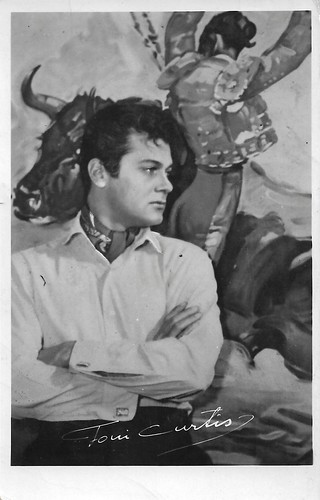
Vintage photo, ca. 1955. The poster behind Curtis is of Plaza de Toros, Cordoba. A few photos with this poster as a backdrop have been made, but we could not trace the photographer.

French postcard by Editions P.I., Paris, license holder for Ufa, no. CK-43. Photo: Universal Film, Inc.
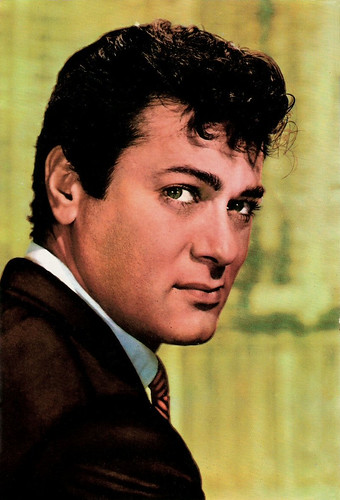
Spanish postcard by Raker, no. 1021.

Israelian postcard by Editions de Luxe, no. 103.

Vintage collectors card by Rea Sweets of Quality, series H, no. 1. Photo: Universal.

Vintage collectors card by Rea Sweets of Quality, series H, no. 54. Photo: Universal.
Bernard Schwartz becomes Tony Curtis
In 1945, Tony Curtis was honourably discharged from the Navy, and when he realised that the GI Bill would allow him to go to acting school without paying for it, he saw that his lifelong pipe dream of being an actor might actually be achievable. Curtis auditioned for the New York Dramatic Workshop and was accepted on the strength of his audition piece, a scene from 'Dr. Jekyll and Mr. Hyde' in pantomime.
In 1947, he studied acting under the influential German stage director Erwin Piscator. His contemporaries included Elaine Stritch, Harry Belafonte, Walter Matthau, Beatrice Arthur, and Rod Steiger. He then began to pay his dues by appearing in a slew of stage productions, including 'Twelfth Night' and 'Golden Boy'. While still at college, Curtis was discovered by Joyce Selznick, a talent agent, casting director, and niece of film producer David O. Selznick.
After seeing his potential, Selznick arranged an interview for Curtis to see David O. Selznick at Universal Studios, where the 23-year-old Curtis was offered a seven-year contract. He changed his name from Bernard Schwartz to what he saw as an elegant, mysterious moniker, Tony Curtis, named after the novel 'Anthony Adverse' (1936) by Hervey Allen and a cousin of his named Janush Kertiz.
Curtis began making a name for himself by appearing in small, offbeat roles in low-budget productions. His first notable performance was a two-minute role as a rumba dancer in Criss Cross (Robert Siodmak, 1949), in which he made Burt Lancaster jealous by dancing with Yvonne De Carlo. This offbeat role resulted in Curtis's being typecast as a heavy for the next few years, such as playing a gang member in City Across the River (Maxwell Shane, 1949), starring Stephen McNally.
Curtis continued to build up a showreel by accepting any paying job, acting in some bit-part roles for the next few years. It wasn't until late 1949 that he finally got the chance to demonstrate his acting flair when he was cast in an important role in an action-Western, Sierra (Alfred E. Green, 1950) starring Audie Murphy. On the strength of his performance in that film, Curtis was finally cast in a big-budget movie, Winchester '73 (Anthony Mann, 1950). While he appears in that film only very briefly, it was a chance for him to act alongside a Hollywood legend, James Stewart.

Dutch postcard by Takken, Utrecht, no. 686. Photo: Universal International. Tony Curtis and Piper Laurie in The Prince Who Was A Thief (Rudolph Maté, 1952).
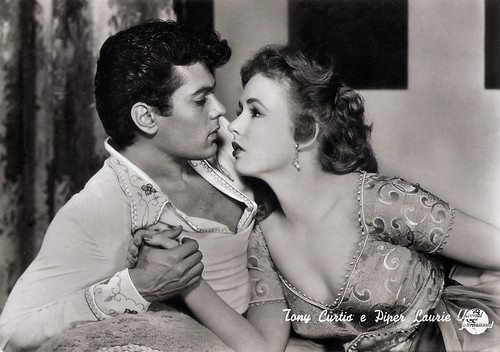
Italian postcard by Bromofoto, Milano, no. 400. Photo: Universal International. Tony Curtis and Piper Laurie in The Prince Who Was A Thief (Rudolph Maté, 1952).

Dutch postcard by Uitg. Takken, no. 1578. Photo: Universal International. Tony Curtis in The Prince Who Was a Thief (Rudolph Maté, 1952).

Dutch postcard by Takken, no. 2086. Photo: Tony Curtis in Flesh and Fury (Joseph Pevney, 1952).

Dutch postcard, no. 19. Photo: Tony Curtis in Flesh and Fury (Joseph Pevney, 1952).

German postcard by Ufa/Film-Foto, Berlin-Templehof, no. FK 3390. Photo: Universal Film, Inc.
Swashbucklers, Film Noirs, and frantic comedies
Tony Curtis was receiving numerous fan letters, so Universal awarded him the starring role in The Prince Who Was a Thief (Rudolph Maté, 1951), a Swashbuckler set in the Middle East with Piper Laurie. It was a hit at the box office and Curtis was now established.
He followed it up with a role as a boxer in the Film Noir Flesh and Fury (Joseph Pevney, 1952), with Jan Sterling. His next films were the comedy No Room for the Groom (Douglas Sirk, 1952), and Son of Ali Baba (Kurt Neumann, 1952), another film set in the Arab world with Piper Laurie.
Curtis then teamed up with then-wife Janet Leigh in Houdini (George Marshall, 1953), in which Curtis played the title role. He reunited with Burt Lancaster in the prestigious action drama Trapeze (Carol Reed, 1956), also starring Gina Lollobrigida. It was one of the biggest hits of the year.
As his career developed, Tony Curtis wanted to act in films that had social relevance, ones that would challenge audiences. He achieved his first serious recognition as a dramatic actor in Sweet Smell of Success (Stanley Kramer, 1957) with co-star Burt Lancaster. The following year he was nominated for an Academy Award for Best Actor in The Defiant Ones (Stanley Kramer, 1958) alongside Sidney Poitier who was also nominated in the same category.
Curtis then gave what could arguably be called his best performance: three interrelated roles in the now-classic comedy Some Like It Hot (Billy Wilder, 1959) opposite Jack Lemmon and Marilyn Monroe. That was followed by Operation Petticoat (Blake Edwards, 1959) with Cary Grant. These frantic comedies displayed his impeccable comic timing. He often collaborated with Blake Edwards on later films.
In 1960, Curtis played a supporting role in Stanley Kubrick's Spartacus (1960). He was advised against appearing as the subordinate sidekick of Spartacus, playing second fiddle to the equally famous Kirk Douglas. However, Curtis saw no problem with this because the two had recently acted together in dual leading roles in The Vikings (Richard Fleischer, 1958). Spartacus became another major hit for him.

Italian postcard by Rotalfoto, Milano. Photo: Universal International. Tony Curtis and Joanne Dru in Forbidden (Rudolph Maté, 1953).

German postcard by Kolibri-Verlag, G.m.b.H., Minden-Westf., no. 2180. Photo: Production Hecht-Lancaster. Burt Lancaster, Gina Lollobrigida and Tony Curtis in Trapeze (Carol Reed, 1956).
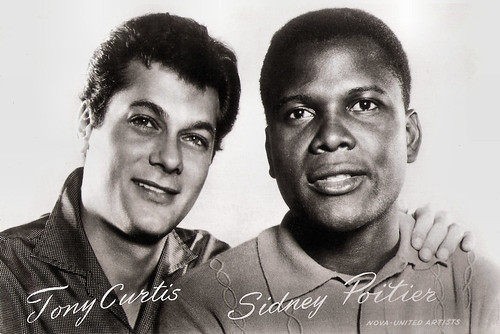
Dutch postcard by Uitg. Takken, Utrecht, no. AX 3896. Photo: Nova / United Artists. Tony Curtis and Sidney Poitier in The Defiant Ones (Stanley Kramer, 1958).

Czech postcard by Pressfoto, Praha (Prague). Photo: Jack Lemmon and Tony Curtis in Some Like It Hot (Billy Wilder, 1959). Collection: Carla Bosch.
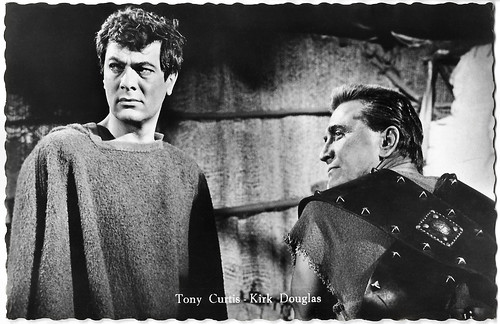
Dutch postcard, no. 1160. Photo: Universal International. Tony Curtis and Kirk Douglas in Spartacus (Stanley Kubrick, 1960).

Yugoslavian postcard by Z.K., no. 1399. Tony Curtis in Spartacus (Stanley Kubrick, 1960).

French postcard in the Entr'acte series by Éditions Asphodèle. Mâcon, no. 001/27. Photo: Tony Curtis and Kirk Douglas at the set of Spartacus (Stanley Kubrick, 1960). Caption: Tony Curtis and Kirk Douglas discuss a film shot.
His chilling portrayal of a serial killer
Tony Curtis's stardom and film career declined considerably after 1960. Curtis took on the role of the Ukrainian Cossack Andrei in the historical action romance epic Taras Bulba (J. Lee Thompson, 1962) featuring Yul Brynner and also with German actress Christine Kaufmann, who became Curtis' second wife.
Curtis then focused on comedies such as Sex and the Single Girl (Richard Quine, 1964), with Natalie Wood; The Great Race (Blake Edwards, 1965), with Wood and Jack Lemmon, and Boeing Boeing (John Rich, 1965) a sex farce with Jerry Lewis.
His most significant dramatic part came in 1968 when he starred in the true-life drama The Boston Strangler (Richard Fleischer, 1968), which some consider his last major film role. The part reinforced his reputation as a serious actor with his chilling portrayal of serial killer Albert DeSalvo.
He later starred alongside Roger Moore in the TV series The Persuaders! (1971), with Curtis playing American millionaire Danny Wilde. The series ran twenty-four episodes.
In 2008, he published his autobiography 'American Prince: A Memoir' in which he accused many people he worked with of holding anti-Semitic views. He settled in Henderson, Nevada, where he eventually died in 2010. He was 85.
Tony Curtis was married six times and had six children. His wives were actress Janet Leigh (1951-1962), German actress Christine Kaufmann (1963-1968), Leslie Curtis (1968-1982), Andrea Savio (1984-1992), Lisa Deutsch (1993-1994), and Jill Vandenberg Curtis (1998-2019 - his death).
He was the father of Jamie Lee Curtis and Kelly Curtis (with Janet Leigh), Allegra Curtis, and Alexandra Curtis (with Christine Kaufmann), Nicholas Curtis, and Benjamin Curtis (with Leslie Curtis).
He became largely estranged from all six of his children. His son Nicholas Curtis, died of seizures due to an overdose of heroin in 1994. He disinherited all of his children from his will and left the bulk of his estate to his wife Jill Vandenberg Curtis, who was 46 years younger than he.

Spanish postcard by Archivo Bermejo, no. C 44. Photo: Universal International. Janet Leigh and Tony Curtis kiss.

Swedish postcard by Förlag Torsten G. Ericsson, Hälsingborg, no. AX 865. Photo: Metro-Goldwyn-Mayer. Janet Leigh and Tony Curtis embrace.

Dutch postcard by Takken / 't Sticht, Utrecht, no. 1593.

British postcard in the Picturegoer Series, London, no. D. 146. Photo: Universal International.

Dutch postcard by Gebr. Spanjersberg N.V., Rotterdam, no. 5430.

Dutch postcard by Gebr. Spanjersberg N.V., Rotterdam, no. 4741, licence holder for the Netherlands of Ufa, Berlin-Tempelhof. Photo: Terb-Agency / Ufa.

Dutch postcard by Uitg. Takken, Utrecht, no. 3145. Photo: Universal Int.

Italian postcard by Rotalfoto, Milano, no. 324. Photo: Universal International.

Italian postcard by B.F.F. (Ballerini & Fratini, Firenze), no. 3054. Photo: Universal International.

German postcard by ISV, no. H 45.
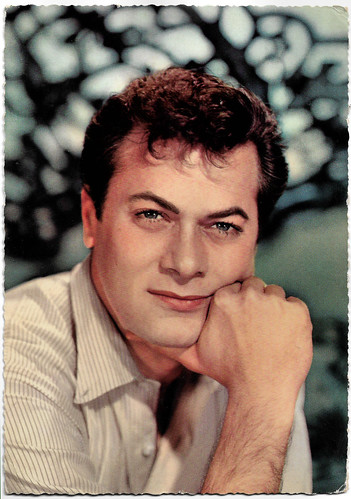
German postcard by Krüger / Ufa. Photo: Ufa. Sent by mail in the Netherlands in 1966.

Danish postcard by Forlaget Holger Danske, no. 119. Photo: Tony Curtis and Roger Moore in The Persuaders (1971-1972).
Source: James Briggs (IMDb), Wikipedia, and IMDb.
This post was last updated on 11 November 2023.
No comments:
Post a Comment